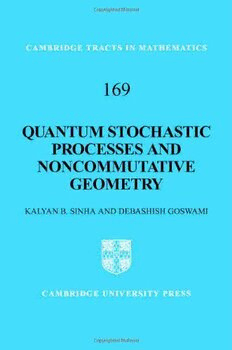Table Of ContentThis page intentionally left blank
CAMBRIDGETRACTSINMATHEMATICS
GeneralEditors
B.BOLLOBAS,W.FULTON,A.KATOK,F.KIRWAN,
P.SARNAK,B.SIMON
169QuantumStochasticProcessesandNoncommutative
Geometry
CAMBRIDGETRACTSINMATHEMATICS
GENERALEDITORS
B.BOLLOBAS,W.FULTON,A.KATOK,F.KIRWAN,P.SARNAK,B.SIMON
Acompletelistofbooksintheseriescanbefoundat
http://www.cambridge.org/series/sSeries.asp?code=CTM
Recenttitlesincludethefollowing:
140. DerivationandIntegration.ByW.F.PFEFFER
141. FixedPointTheoryandApplications.ByR.P.AGARWAL,M.MEEHAN,
andD.O’REGAN
142. HarmonicMapsbetweenRiemannianPolyhedra.ByJ.EELLSandB.FUGLEDE
143. AnalysisonFractals.ByJ.KIGAMI
144. TorsorsandRationalPoints.ByA.SKOROBOGATOV
145. IsoperimetricInequalities.ByI.CHAVEL
146. RestrictedOrbitEquivalenceforActionsofDiscreteAmenableGroups.
ByJ.KAMMEYERandD.RUDOLPH
147. FloerHomologyGroupsinYang–MillsTheory.ByS.K.DONALDSON
148. GraphDirectedMarkovSystems.ByD.MAULDINandM.URBANSKI
149. CohomologyofVectorBundlesandSyzygies.ByJ.WEYMAN
150. HarmonicMaps,ConservationLawsandMovingFrames.ByF.HE´LEIN
151. FrobeniusManifoldsandModuliSpacesforSingularities.ByC.HERTLING
152. PermutationGroupAlgorithms.ByA.SERESS
153. AbelianVarieties,ThetaFunctionsandtheFourierTransform.
ByA.POLISHCHUK
154. FinitePackingandCovering,K.BO¨RO¨CZKY,JR
155. TheDirectMethodinSolitonTheory.ByR.HIROTA.Editedandtranslated
byA.NAGAI,J.NIMMO,andC.GILSON
156. HarmonicMappingsinthePlane.ByP.DUREN
157. AffineHeckeAlgebrasandOrthogonalPolynomials.ByI.G.MACDONALD
158. Quasi-FrobeniusRings.ByW.K.NICHOLSONandM.F.YOUSIF
159. TheGeometryofTotalCurvature.ByK.SHIOHAMA,T.SHIOYA,
andM.TANAKA
160. ApproximationbyAlgebraicNumbers.ByY.BUGEAUD
161. EquivalenceandDualityforModuleCategories.ByR.R.COLBY,
andK.R.FULLER
162. Le´vyProcessesinLieGroups.ByMINGLIAO
163. LinearandProjectiveRepresentationsofSymmetricGroups.ByA.KLESHCHEV
164. TheCoveringPropertyAxiom,CPA.K.CIESIELSKIandJ.PAWLIKOWSKI
165. ProjectiveDifferentialGeometryOldandNew.ByV.OVSIENKO
andS.TABACHNIKOV
166. TheLe´vyLaplacian.ByM.N.FELLER
167. Poincare´DualityAlgebras,Macaulay’sDualSystems,andSteenrodOperations.
ByD.M.MEYERandL.SMITH
168. TheCube:AWindowtoConvexandDiscreteGeometry.ByCHUANMINGZONG
169. QuantumStochasticProcessesandNoncommutativeGeometry.
ByKALYANB.SINHAandDEBASHISHGOSWAMI
QUANTUM STOCHASTIC
PROCESSES
AND NONCOMMUTATIVE
GEOMETRY
KalyanB.Sinha
IndianStatisticalInstitute
NewDelhi,India
DebashishGoswami
IndianStatisticalInstitute
Kolkata,India
CAMBRIDGE UNIVERSITY PRESS
Cambridge, New York, Melbourne, Madrid, Cape Town, Singapore, São Paulo
Cambridge University Press
The Edinburgh Building, Cambridge CB2 8RU, UK
Published in the United States of America by Cambridge University Press, New York
www.cambridge.org
Information on this title: www.cambridg e.org /9780521834506
© K. Sinha and D. Goswami
This publication is in copyright. Subject to statutory exception and to the provision of
relevant collective licensing agreements, no reproduction of any part may take place
without the written permission of Cambridge University Press.
First published in print format 2007
ISBN-13 978-0-511-26904-2 eBook(EBL)
ISBN-10 0-511-26904-8 eBook(EBL)
ISBN-13 978-0-521-83450-6 hardback
ISBN-10 0-521-83450-3 hardback
Cambridge University Press has no responsibility for the persistence or accuracy of urls
for external or third-party internet websites referred to in this publication, and does not
guarantee that any content on such websites is, or will remain, accurate or appropriate.
Contents
Preface vii
Notation ix
1 Introduction 1
2 Preliminaries 7
∗
2.1 C andvonNeumannalgebras 7
2.2 Completelypositivemaps 20
2.3 Semigroupsoflinearmapsonlocallyconvexspaces 26
2.4 FockspacesandWeyloperators 30
3 Quantumdynamicalsemigroups 33
3.1 Generatorsofuniformlycontinuousquantumdynamical
semigroups:thetheoremsofLindbladandChristensen–Evans 33
3.2 Thecaseofstronglycontinuousquantumdynamical
semigroups 39
4 Hilbertmodules 79
∗
4.1 HilbertC -modules 79
4.2 HilbertvonNeumannmodules 88
4.3 GroupactionsonHilbertmodules 95
5 Quantumstochasticcalculuswithboundedcoefficients 103
5.1 Basicprocesses 103
5.2 StochasticintegralsandquantumItoˆ formulae 113
5.3 Hudson–Parthasarathy(H–P)typeequations 127
5.4 Map-valued,E–H-typequantumstochasticcalculus 133
6 Dilationofquantumdynamicalsemigroupswith
boundedgenerator 147
6.1 Hudson–Parthasarathy(H–P)dilation 149
6.2 ExistenceofstructuremapsandE–HdilationofT 150
t
6.3 Adualityproperty 154
v
vi Contents
6.4 AppearanceofPoissontermsinthedilation 156
6.5 ImplementationofE–Hflow 160
∗
6.6 DilationonaC -algebra 161
6.7 Covariantdilationtheory 164
7 Quantumstochasticcalculuswithunboundedcoefficients 169
7.1 Notationandpreliminaryresults 169
7.2 Q.S.D.E.withunboundedcoefficients 173
7.3 Application:quantumdampedharmonicoscillator 181
8 Dilationofquantumdynamicalsemigroupswithunbounded
generator 185
8.1 Dilationofaclassofcovariantquantumdynamical
semigroups 185
8.2 Dilationofquantumdynamicalsemigroups
onU.H.F.algebra 218
9 Noncommutativegeometryandquantumstochasticprocesses 231
9.1 BasicsofdifferentialandRiemanniangeometry 231
9.2 HeatsemigroupandBrownianmotiononclassicalmanifolds 238
9.3 Noncommutativegeometry 248
9.4 Examples 253
9.5 AsymptoticanalysisofheatsemigroupsandLaplacians 264
9.6 QuantumBrownianmotiononnoncommutativemanifolds 273
References 281
Index 289
Preface
On the one hand, in almost all the scientific areas, from physical to social
sciences, biology to economics, from meteorology to pattern recognition in
remote sensing, the theory of classical probability plays a major role and on
the other much of our knowledge about the physical world at least is based
on the quantum theory [12]. In a way, quantum theory itself is a new kind of
theoryofprobability(inthelanguageofvonNeumannandBirkhoff)(seefor
example[106])whichcontainstheclassicalmodel,andthereforeitisnatural
toextendtheotherareasofclassicalprobabilitytheory,inparticularthetheory
ofMarkovprocessesandstochasticcalculustothisquantummodel.
Therearemorethanonepossibleways(seeforexample[127])toconstruct
theabove-mentionedextensionandinthisbookwehavechosentheoneclos-
est to the classical model in spirit, namely that which contains the classical
theoryasasubmodel.Thisrequirementhasruledoutanydiscussionofareas
such as freeand monotone-probability models. Once we accept this quantum
probabilistic model, the ‘grand design’ that engages us is the ‘canonical con-
structionofa∗-homomorphicflow(satisfyingasuitabledifferentialequation)
onagivenalgebraofobservablessuchthattheexpectationsemigroupispre-
ciselythegivencontractivesemigroupofcompletelypositivemapsonthesaid
algebra’.
This problem of ‘dilation’ is here solved completely for the case when the
semigroup has a bounded generator, and also for the more general case (of
anunboundedgenerator)withcertainadditionalconditionssuchassymmetry
and/orcovariancewithrespecttoaLiegroupaction.However,acertainamount
ofspacehastobedevotedtodeveloptheneededtechniquesandstructures,and
thereaderisexpectedtobewellequippedwiththebasicsoffunctionalanalysis,
theoryofHilbertspacesandofoperatorsinthemandofprobabilitytheoryin
ordertomasterthese.
Abeginnerwiththeabove-mentionedbackgroundmayreadChapters1to6
atfirstandmayleavetherestforasecondreading.Insomeplaces,mathemat-
ical assertions have been made without proof wherever we felt that the proof
is essentially similar to a detailed proof of an earlier statement or when the
verificationofthesamecanbeleftasanexercise.
vii
viii Preface
Duetolackofspace,notallequationshavebeendisplayedandlongexpres-
sions had to be broken at the end of a line, any inconvenience due to this is
regretted.Theopensquaresymboldenotestheendofaproof.Thereferencelist
isfarfromcomplete,wehaveoftenincludedonlyarecentorarepresentative
paper.Weapologizeforanyunintendedexclusionofareference.
Itisapleasuretorememberherepeoplewhohavecontributedtothepreparation
ofthisbook.ProfessorK.R.Parthasarathywasinstrumentalinintroducingus
to the subject and one of us (K.B.S.) has collaborated with him extensively
overnearlytwodecades;withouttheinsightsandmasterlyexpositionsofhim
and of Professor P. A. Meyer, the subject may not have reached the stage it
is in now. We thank all our friends, collaborators and members of the Q–P
club who have helped us directly or indirectly in this endeavor. In particular,
we must mention Professors Luigi Accardi, Robin Hudson, V. P. Belavkin,
MartinLindsay,FrancoFagnola,StephaneAttal,Jean-LucSauvageot,Burkhard
Ku¨mmerer, Hans Maassen, Rajarama Bhat and Dr Arup Pal and Dr Partha
Sarathi Chakraborty. We are grateful to the Indian Statistical Institute (both
DelhiandKolkatacampuses)forprovidingthenecessaryfacilities,Indo-French
CentreforthePromotionofAdvancedResearchandDST-DAADagenciesfor
making many collaborations possible. One of us (D.G.) would like to thank
theAlexandervonHumboldtFoundationforapostdoctoralfellowshipduring
2000–01(andalsolatervisitsunderitsschemeof‘resumptionoffellowship’),
when part of the work covered by this book was done. We must also thank
Dr Lingraj Sahu, who as a graduate student at a critical stage of writing the
monograph, helped with introduction of a part of the material and Mr Joydip
Janaforhelpwithproofreading.Oneoftheauthors(D.G.)dedicatesthisbook
to his wife, Gopa and the youngest addition to his family, expected possibly
before this book sees the light of the day; and acknowledges with gratitude
the constant encouragement and support from his parents, mother-in-law and
Amit-daduringthewritingofthebook.
Asisoftenthecaseinanysuchenterprise,someimportanttopics(e.g.stop
times)havebeenleftout.Theresponsibilityforthechoiceoftopicsaswellas
for any omissions and shortcomings of the text is entirely ours. We can only
hopethatthismonographwillenthusesomeresearchersandstudentstosolve
someoftheproblemsleftunsolved.
K.B.Sinha
DebashishGoswami

